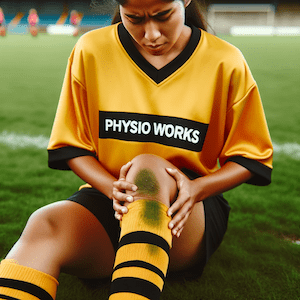
Football & Soccer Injuries Management and Prevention Tips
Understanding the Risks and Prevention
Football, also known as soccer, is a sport loved globally, attracting millions of players and fans. Its fast pace and high physical demands, however, make injuries a common and unfortunate reality.
This article, from a physiotherapist’s perspective, will explore prevalent soccer injuries, their causes, prevention methods, and the importance of proper rehabilitation. We aim to provide players, coaches, and enthusiasts with the knowledge to enhance safety and enjoyment in the sport.
What are the Most Common Soccer Injuries?
Ankle Sprains
Ankle sprains are the most frequent soccer injuries. They occur when ligaments in the ankle are stretched or torn, typically due to sudden directional changes, collisions, or awkward landings. Severity can range from mild stretches to serious ligament tears.
Preventive measures include proper warm-up routines, strengthening exercises, and supportive footwear. Recent studies suggest that proprioceptive training can further reduce the risk of ankle sprains.
Hamstring Strains
Football players often experience hamstring strains, particularly during sprinting, kicking, or sudden accelerations. These strains are exacerbated by inadequate warm-up, muscle imbalances, fatigue, and poor flexibility. Preventative strategies to reduce soccer injuries include conditioning exercises, stretching, and ensuring proper muscle balance through strength training.
Knee Injuries
Knee injuries, including ACL, MCL, and meniscus tears, are prevalent soccer injuries. They generally result from sudden directional changes, direct knee impacts, or awkward landings. Strengthening and stability exercises, correct footwear, and proper tackling techniques are essential in reducing these risks.
Groin Strains
Groin strains impact the inner thigh muscles, especially during cutting, kicking, and sudden directional changes. Insufficient warm-up, muscle imbalances, and lack of flexibility are key contributors. Soccer injuries prevention strategies involve a comprehensive training program focusing on strength, flexibility, and proper warm-up and cool-down routines.
Head Injuries
Head injuries, including concussions, are increasingly concerning in football. They can result from heading the ball, player collisions, and falls. To minimise these risks, it’s crucial to use proper heading techniques, protective headgear, and enforce fair play rules. Immediate medical attention and strict adherence to return-to-play protocols are vital in managing concussions.

Is Soccer a High Injury Sport?
Prevention and Rehabilitation
Preventing football injuries requires a holistic approach. Players should maintain overall fitness, including cardiovascular endurance, strength, and flexibility. Warm-up and cool-down routines are crucial, as is wearing appropriate protective gear. Coaches and trainers should focus on correct techniques and injury prevention exercises.
Football Australia Perform+ Warm-up & Injury Prevention Program
The “Football Australia Perform+” program, developed by sports medicine experts, focuses on specific muscle training, balance exercises, and safe jumping and landing techniques. This program aims to enhance the body’s natural defence against football-related injuries.
Injured? What to Do
When soccer injuries occur, prompt and appropriate rehabilitation is key to a full recovery. Players should seek immediate medical attention, adhere to their healthcare provider’s recommendations, and participate in physiotherapy programs to regain strength, flexibility, and coordination. Returning to play before complete recovery can lead to re-injury and long-term health issues.
FFA Sports Insurance Program
The FFA National Insurance Programme provides basic coverage for football players and administrators. While it’s not comprehensive, it plays a crucial role in maintaining the affordability of football registration. It’s advised to supplement this with private health insurance.
FFA Sports Insurance Program Information
Conclusion
Football’s physical demands inherently carry injury risks. Understanding common injuries, their causes, and prevention strategies is crucial for players, coaches, and trainers. By incorporating proper warm-up routines, strength and flexibility exercises, and maintaining overall fitness, players can enjoy football more safely and effectively.
Seeking Professional Advice
Consulting a physiotherapist is crucial when dealing with football injuries. Physiotherapists provide professional advice, tailored exercises, and rehabilitation strategies to ensure a safe return to the game. For more information on managing football injuries, visit your PhysioWorks physiotherapist, an invaluable resource offering football injury guidance and up-to-date research.
Related Articles Recommendations:
- Common Tendinopathies: An Overview of Tendon Injuries – Readers can gain insights into tendon injuries, often encountered in soccer/football, and their management.
- Physiotherapy Treatment: Strategies for Healing and Mobility – This article provides a broad overview of physiotherapy treatments relevant to soccer/football injuries.
- Strengthening: Dynamics of an Effective Warm-Up – Essential reading for soccer/football players to understand the importance of warm-up routines in injury prevention.
- Sports Injury Management – Offers valuable information on managing common sports injuries, relevant to soccer/football players.
- Foot Pain: Understanding Causes and Treatments – Since soccer/football heavily involves footwork, this article helps understand foot pain causes and treatments.
- Acute Sports Injury Clinic: Prevention and Management Strategies – Provides strategies for preventing and managing muscle injuries, crucial in soccer/football.
- Physiotherapy & Exercise Prescription – Highlights the role of exercise in treating soccer/football-related injuries.



















































































